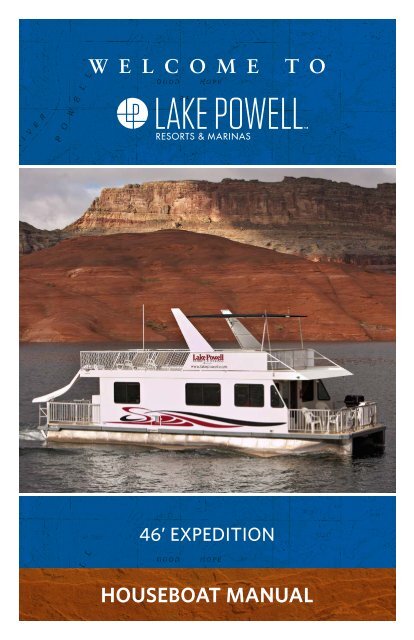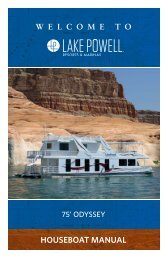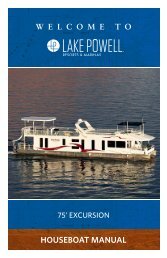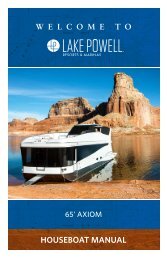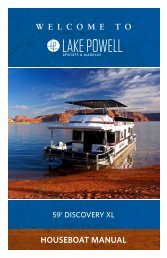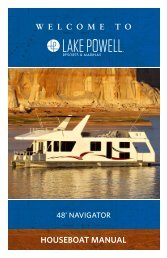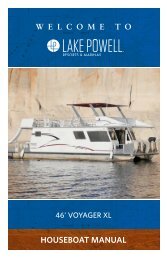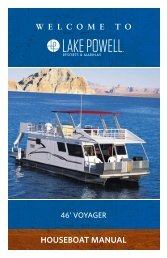46' Expedition Houseboat Manual
You also want an ePaper? Increase the reach of your titles
YUMPU automatically turns print PDFs into web optimized ePapers that Google loves.
W E L C O M E T O<br />
46’ EXPEDITION<br />
HOUSEBOAT MANUAL
TABLE OF CONTENTS<br />
Marine Radio......................................................................................................1<br />
Engines/Helm................................................................................................... 3<br />
<strong>Houseboat</strong> Batteries........................................................................................6<br />
Generator...........................................................................................................8<br />
Water Pressure............................................................................................... 10<br />
Hot Water........................................................................................................ 12<br />
Holding Tanks...................................................................................................13<br />
Gas/Propane................................................................................................... 15<br />
Refrigerator...................................................................................................... 17<br />
Range................................................................................................................. 19<br />
Grill.................................................................................................................... 20<br />
Heater................................................................................................................ 21<br />
Cooling..............................................................................................................22<br />
Accessories......................................................................................................23
MARINE RADIO<br />
Say “_________ (the name of the marina<br />
you are calling) BOAT RENTALS this is<br />
houseboat # _____” (number of your<br />
houseboat). For example: “Bullfrog Boat<br />
Rentals, this is houseboat # S11.”<br />
Your houseboat has come equipped with<br />
a VHF Marine Band Radio. It is located at<br />
the helm, to the left of the steering wheel.<br />
ON/OFF<br />
• Turn the volume Knob in a clockwise<br />
direction to turn on the radio.<br />
• Make sure the H/L (high/low<br />
frequency) button is on the Hi<br />
position.<br />
CHANNEL 16<br />
Use Channel 16 for hailing and<br />
emergencies only. Never use Channel 16<br />
for routine conversations.<br />
In case of an emergency, hail the National<br />
Park Service on channel 16. They monitor<br />
this channel 24 hours a day.<br />
When communication is established,<br />
we will direct you to another channel.<br />
Commonly used channels are 10, 12,<br />
68 and 72. Be sure to acknowledge<br />
that channel, before you change to the<br />
channel. Then turn to that channel, and<br />
we will continue the conversation.<br />
Information you will need when you<br />
call us:<br />
1. Your boat number.<br />
2. Your exact location, if known.<br />
3. Description of the problem.<br />
4. Any details on the trouble-shooting<br />
you have already tried.<br />
If you need assistance we will attempt<br />
to help you troubleshoot a problem over<br />
the radio. If we are not successful, we will<br />
dispatch a technician out to help you.<br />
For safety, our technicians can only be<br />
dispatched if they can fix the problem<br />
and return to our docks before dark. If<br />
we receive your call late in the day, we<br />
will gladly respond first thing the next<br />
morning.<br />
To hail Boat Rentals, turn radio ON and<br />
to Channel 16, depress button on side of<br />
handheld microphone to talk, and release<br />
the button when you are finished talking.<br />
The Boat Rentals Office monitors this<br />
channel during regular business hours.<br />
1
WEATHER<br />
W/X button or Channel 1 on your marine<br />
radio is the weather channel.<br />
This channel is updated periodically by<br />
the National Weather Service.<br />
Be sure to check this channel regularly<br />
during your trip to keep apprised of the<br />
changing weather conditions here at Lake<br />
Powell.<br />
REQUEST FOR ASSISTANCE CARD<br />
If for some reason you cannot reach us<br />
by Marine Radio, fill out your Request for<br />
Assistance Card located in your manual.<br />
Flag down a boat passing by and ask<br />
them to take it to the nearest marina for<br />
assistance.<br />
We will dispatch a technician out to your<br />
boat as soon as we can safely do so.<br />
OTHER INFO<br />
Do NOT use VHF antenna as a flag pole<br />
or hang anything on the antenna.<br />
Channel 26 is the Marine Operator.<br />
Marine Radios transmit line-of-sight. So if<br />
you are back in a canyon, you may have to<br />
ask assistance from another boater with a<br />
radio to help contact us if you cannot get<br />
through directly.<br />
Profanity over the public airways is a<br />
federal crime.<br />
Reminder: Your Marine Radio is not a<br />
toy and should be operated only by a<br />
responsible adult.<br />
A VHF marine radio is not the same<br />
as a Citizen’s Band Radio. CB lingo and<br />
10-codes are not used.<br />
COMMON TROUBLESHOOTING<br />
PROBLEM POSSIBLE CAUSES REMEDIES<br />
Not transmitting<br />
or receiving<br />
Low house battery<br />
Radio not set on USA<br />
Radio blocked by<br />
canyon walls<br />
Set on 1 watt mode<br />
Antenna has fallen<br />
down<br />
Charge house battery<br />
Push USA/Int button<br />
Move the houseboat to<br />
open water<br />
Push 1/25or Hi/Lo button<br />
to change to 25 watt<br />
Raise antenna<br />
2
ENGINES/HELM<br />
YOUR HOUSEBOAT HAS<br />
TWO ENGINES…<br />
• For greater maneuverability<br />
and power.<br />
• To provide you with a spare in case<br />
of engine failure.<br />
Your engines are well maintained, but<br />
occasional breakdowns can occur. The<br />
spare is to ensure your safety and save<br />
you inconvenience. Don’t let the loss of<br />
one engine delay your vacation. Proceed<br />
on your planned itinerary with the good<br />
engine and we will catch up to you as<br />
soon as possible and make necessary<br />
repairs.<br />
GAUGES<br />
Tachometer<br />
• Monitors the engine revolutions.<br />
• Wide-Open Throttle (WOT)<br />
should be 4800-5200 RPM’s.<br />
• The most efficient cruising RPM<br />
will be 3800-4200 RPM<br />
Fuel Gauge<br />
• Key must be on for fuel level<br />
to register.<br />
• Right gauge is for the Toy Tank<br />
• Left gauge is for both engines and<br />
the Generator<br />
Horn<br />
• Push in the HORN button<br />
at the helm.<br />
THROTTLE<br />
Setting Neutral Throttle for Starting<br />
• Confirm that the throttle is in<br />
neutral position.<br />
• Turn the key to first click – Beeper<br />
will sound.<br />
• Push and hold “black” command<br />
button the red light will go solid and<br />
the beeping will stop.<br />
• Turn key to engage starter. If the<br />
engine fails to start in 10 seconds,<br />
return key to ON position, wait 30<br />
seconds and try again.<br />
• If the engine fails to start push<br />
and hold the command button<br />
while pushing the throttles forward<br />
one detent. This will alloy you to<br />
increase the RPM’s for starting only.<br />
• Return throttle lever to center<br />
position after warm-up.<br />
• Red light will be solid to indicate<br />
that the shift control is activated,<br />
and lever movement will engage<br />
prop.<br />
• If engine is still difficult to start,<br />
squeeze primer bulb, located on the<br />
fuel line near the engine, until firm.<br />
Cold Start<br />
• Same as regular start, but warm up<br />
time needs to be extended.<br />
NAUTICAL NOTE: When leaving a dock,<br />
signal with 1 long blast (4 seconds) and<br />
3 short blasts (1 second each).<br />
3
GETTING UNDER WAY<br />
From Neutral Throttle<br />
• Return throttle to neutral position.<br />
• Red light on controls will be solid.<br />
• Push throttle lever forward to go<br />
forward or pull back for reverse.<br />
• Advance throttle to increase speed.<br />
• Always pause in neutral before<br />
changing gears.<br />
Shut Down<br />
• Return throttles to neutral position.<br />
• Turn key to off.<br />
HYDRO-LOCK<br />
Hydro-locking of an engine occurs when<br />
water enters the engine cylinders. The<br />
starter will click, but the engine won’t<br />
turn over.<br />
Caused by<br />
• Overloading the back deck.<br />
• Large waves behind boat.<br />
• Dropping lake level which increases<br />
the angle of a beached boat.<br />
If you suspect your engine has become<br />
hydro-locked, get word to the nearest<br />
marina and a technician will be sent out<br />
help you.<br />
RAISING ENGINE<br />
Electric tilt toggle is located on the left<br />
side of the engine, below the cowling<br />
(cover).<br />
Changing the Prop<br />
• Remove keys from ignition<br />
(to avoid someone else accidentally<br />
starting the engine).<br />
• Raise engine.<br />
• Unscrew lock nut.<br />
• Remove spacer washer.<br />
• Remove Prop.<br />
• Reverse procedure to install the new<br />
propeller.<br />
FLYING BRIDGE CONTROLS<br />
Operation from Upper Deck<br />
To get power to the upper deck controls:<br />
• Engines should be running.<br />
• At the lower helm – put engine<br />
control levers in neutral position.<br />
• At the upper helm with the control<br />
handles in neutral – push the “black<br />
“transfer button.<br />
• Red light will come on.<br />
• Push throttle lever forward to go<br />
forward or pull back for reverse<br />
To transfer control back to the lower<br />
helm, set upper helm controls to neutral,<br />
then return to the lower helm and press<br />
the “black” transfer button to regain<br />
control.<br />
Don’t Drive From The Upper Deck:<br />
4
ENGINES/HELM<br />
• In any wakeless area, including the<br />
marina.<br />
• When approaching a dock.<br />
• When approaching a beach<br />
In narrow channels.<br />
• In any situation that requires<br />
maneuvering your vessel, always<br />
pilot from the main helm<br />
Note: Do not try to start the engines<br />
from the upper helm.<br />
.<br />
COMMON TROUBLESHOOTING<br />
PROBLEM POSSIBLE CAUSES REMEDIES<br />
Engine doesn’t turn<br />
over<br />
Engine turns over<br />
but won’t start<br />
Engine won’t turn off<br />
No light on control<br />
Is the throttle in neutral<br />
Low battery<br />
Hydrolock<br />
No fuel<br />
Engine harness has<br />
become Unplugged at<br />
the engine<br />
Turn off key<br />
Put throttle in neutral<br />
Charge battery from the<br />
Generator<br />
Call the marina for help<br />
Squeeze primer bulb,<br />
located on the fuel line<br />
near the engine, until firm.<br />
Unplug the fuel line from<br />
the engine or reconnect<br />
the harness<br />
Reset the MMC breaker<br />
located in the Generator<br />
compartment on the rear<br />
deck<br />
5
HOUSEBOAT BATTERIES<br />
The 12-volt house system includes cabin<br />
lights and navigational lights, water<br />
pumps, the horn and the VHF Radio.<br />
Charging<br />
• Start the Generator following<br />
Generator Starting Procedures.<br />
• Turn on the breaker for the inverter<br />
on the AC panel.<br />
• Charging is most efficient with<br />
unnecessary DC breakers off.<br />
• The engine start batteries will<br />
charge from running the engines.<br />
DC Breaker Panel<br />
• DC Main<br />
• Lights<br />
• Spreader lights<br />
• Water pump<br />
• Fresh water<br />
• Water heater<br />
• Furnace<br />
• Accessories<br />
• Docking lights<br />
• Fuel transfer<br />
• 12 Volt DC outlets<br />
• CD Player<br />
• Refrigerator<br />
Please Note:<br />
• Turn off the WATER PUMP breaker<br />
while underway, beaching, or<br />
unbeaching. Once you are beached,<br />
leave this breaker off for an<br />
additional 15 minutes to let sand<br />
and sediment in the water settle.<br />
It is not necessary to switch on the bilge<br />
pump unless water is noted. The bilge<br />
pump is wired to automatically switch on<br />
when water is present.<br />
DC Breaker<br />
• If you should lose DC power and your<br />
batteries are fully charged, reset the<br />
DC breaker located located in the<br />
generator compartment above the<br />
house batteries.<br />
BATTERY TEST<br />
1. House Battery<br />
• Located in the upper center of the<br />
main panel is the DC volt gauge.<br />
• Push toggle switch to position 1<br />
• Should be between 11-13 volts when<br />
generator is not running.<br />
• When generator is running and the<br />
Inverter is on, should be 12.5 volts or<br />
greater.<br />
• The Generator must be run 6 to 8<br />
hrs per day to keep the batteries<br />
charged.<br />
A low battery alarm will sound and the<br />
LED on the control panel will flash when<br />
the battery’s drop to 10.5 volts.<br />
1. DC power will shut down at 10 volts.<br />
2. Engine or Start Battery. Push toggle<br />
switch to position 2. Should be 12<br />
or greater when generator is not<br />
running.<br />
When generator is running, should<br />
be 12.5 or greater.<br />
3. Generator Crank Battery<br />
Push toggle switch down and the<br />
volts will register.<br />
Should be 12 or greater when<br />
generator is not running.<br />
When generator is running, should<br />
be 12.5 or greater.<br />
Remember: Each light or appliance will<br />
need to be turned on individually<br />
once the breaker is on.<br />
6
HOUSEBOAT BATTERIES<br />
Tips for Getting the Most from your<br />
<strong>Houseboat</strong> Batteries<br />
• When generator is running ALWAYS<br />
have the AC MAIN and BATTERY<br />
CHARGER breakers on.<br />
• Charge daily.<br />
they also require more time to recharge<br />
when they are discharged for too long.<br />
When the lights dim and the pumps slow,<br />
a recharge is overdue.<br />
NOTE:<br />
Deep Cycle batteries are used to extend<br />
the time between charging. However,<br />
COMMON TROUBLESHOOTING<br />
PROBLEM POSSIBLE CAUSES REMEDIES<br />
No DC Power DC<br />
Breaker off<br />
Cabin Light Dim<br />
No Cabin Lights<br />
No Lake Water<br />
Pressure<br />
No Fresh Water<br />
Pressure<br />
House batteries low or<br />
dead<br />
Low house battery<br />
CABIN LIGHTS DC<br />
breakers not on<br />
LAKE WATER PUMP not<br />
on Air lock<br />
Fresh Water Empty<br />
Turn on DC Breaker<br />
Start generator and Turn<br />
on BATTERY CHARGER<br />
Breaker<br />
Start generator and Turn<br />
on BATTERY CHARGER<br />
Breaker<br />
House batteries low or<br />
dead Check Breaker<br />
Start generator and Turn<br />
on BATTERY CHARGER<br />
Breaker<br />
Check LAKE WATER<br />
BREAKER on DC panel<br />
HOLD down the toilet valve<br />
for 15-20 seconds<br />
Refill with Potable Water at<br />
any marina<br />
7
GENERATOR<br />
The Generator is located in the center<br />
hatch on the rear deck of your houseboat.<br />
battery or damage the starter.<br />
• Allow the engine to warm up for 5<br />
minutes.<br />
• Switch the AC MAIN breaker ON.<br />
• You may now turn on individual<br />
breakers to provide power to your<br />
houseboat.<br />
NOTE: Your generator also has an ON/<br />
OFF rocker switch on the generator<br />
Starting/ Warm Up<br />
• Turn on the blower switch<br />
• The remote start is located on the<br />
wall of the cabin at the top of the<br />
stairs to the lower berth.<br />
AC Breaker Panel<br />
• Confirm that the MAIN Switch and<br />
all circuit breakers are OFF.<br />
• Hold the ON switch and<br />
momentarily press the start switch<br />
till the generator starts or for 20<br />
seconds no longer.<br />
• If the engine fails to start, wait 20<br />
seconds and repeat.<br />
NOTE: The engine won’t start with a load<br />
on the circuit. By continually holding the<br />
starter switch, you can run down the<br />
• AC Breaker Panel<br />
• Cabin Outlets<br />
• Galley Outlets<br />
• Air Conditioner<br />
• Inverter (leave on at all times)<br />
• Stove/Microwave<br />
• TV / Stereo<br />
Inverter<br />
The inverter panel is the R6 Remote<br />
Control at the main AC Panel.<br />
The stove, microwave, TV and Stereo all<br />
run off the inverter i.e. these appliances<br />
will all work without the Generator running<br />
• Push power ON on the R6 Remote<br />
• Turn on individual breakers<br />
8
GENERATOR<br />
• GFI Outlets<br />
• Some electrical outlets have a GFI •<br />
breaker. Push in the reset button to<br />
reset.<br />
To Shut Down Generator<br />
• Turn off all AC circuit breakers<br />
• Turn AC MAIN Switch to off<br />
• Push STOP button<br />
TURN OFF BLOWER<br />
the generator must be shut down<br />
immediately to prevent the cooling<br />
system from being fouled with sand<br />
and silt. This can cause overheating and<br />
disable your generator.<br />
Below deck generators are equipped<br />
with coolant (lake water) strainers. Do<br />
not open this unit unless no water is<br />
pumping from the side of the houseboat<br />
during generator oper-ation, or you hear<br />
excessively loud operation:<br />
Special Notes<br />
If your houseboat breaks anchor<br />
and/or drifts sideways onto a beach,<br />
COMMON TROUBLESHOOTING<br />
PROBLEM POSSIBLE CAUSES REMEDIES<br />
No generator power<br />
AC MAIN breaker off<br />
Check breaker on panel<br />
Outlet doesn’t work<br />
Generator Shut down<br />
Generator cranks but<br />
won’t start<br />
CO Alarm beeps<br />
4 beeps every 5<br />
seconds<br />
CO Alarm beeps 1<br />
beeps every minute<br />
Is the generator on? Start generator<br />
AC MAIN breaker off? Check breaker on panel<br />
Is that area’s breaker on? Check breaker on panel<br />
Is GFI tripped?<br />
Reset GFI Outletdeck<br />
Out of Fuel<br />
Check gauges<br />
Out of Fuel<br />
Refuel<br />
Engines/Generator<br />
running<br />
System Error<br />
Turn off Engines/Generator<br />
Evacuate crew out of cabin<br />
Open doors and windows<br />
Press the RESET/SILENCE<br />
Press the REST/SILENCE<br />
button for more than 15<br />
seconds to shut off.<br />
Contact Boat Rentals to<br />
replace alarm.<br />
9
WATER PRESSURE<br />
YOUR HOUSEBOAT IS<br />
SUPPLIED WITH 100<br />
GALLONS OF FRESH WATER.<br />
Fresh Water Holding Tank<br />
• Fresh water refill is located on the<br />
outside starboard front corner and is<br />
marked Shore Water Fill<br />
Lake Water Pressure<br />
• Turn on the Water Pump breaker on<br />
the DC panel.<br />
Faucets<br />
• The kitchen Large Faucet is lake<br />
water.<br />
• Small Faucet is fresh water.<br />
• All sinks and showers empty directly<br />
into the grey-water tank.<br />
• Open only when refilling tank from a<br />
POTABLE water hose located at any<br />
marina.<br />
• The fresh water has as on-demand<br />
pump that operates only when a<br />
faucet is turned ON.<br />
• You must have the breaker for Fresh<br />
Water ON on the DC panel.<br />
Head/Toilet<br />
• Water pump breaker must be on.<br />
• To fill toilet bowl with water, lift up<br />
on the foot pedal for a few seconds.<br />
• To flush, step down on the foot<br />
pedal.<br />
• The head empties directly into the<br />
Black water Tank.<br />
NOTE: Be sure pedal returns to the up<br />
position or flooding can occur.<br />
10
WATER PRESSURE<br />
COMMON TROUBLESHOOTING<br />
PROBLEM POSSIBLE CAUSES REMEDIES<br />
No Lake Water<br />
No fresh water<br />
WATER PRESSURE<br />
breaker may not be on<br />
Low batteries<br />
Lost prime<br />
Turn on breaker<br />
Out of water<br />
Fresh Water breaker<br />
not on<br />
Low batteries<br />
LAKE WATER switch over<br />
the dinette not on<br />
Charge batteries<br />
Press down toilet flush<br />
for about a minute to<br />
restore prime<br />
Refill at marina with<br />
POTABLE water<br />
Turn on Breaker<br />
Note: Not all boats will have a LAKE WATER SWITCH.<br />
11
HOT WATER<br />
YOUR BOAT IS EQUIPPED<br />
WITH A 10-GALLON<br />
CAPACITY WATER HEATER.<br />
To Start<br />
• Turn ON the DC MAIN.<br />
• Turn ON the valve for your propane<br />
tank.<br />
• Turn ON the WATER PUMP breaker<br />
located on the DC panel.<br />
• Turn ON the WATER HEATER<br />
breaker located on the DC panel.<br />
• Turn ON the WATER HEATER switch<br />
located under the main electrical<br />
panel.<br />
• The red light will be on when water<br />
heater is lighting.<br />
• Allow approximately 30 minutes for<br />
the water to heat.<br />
NOTE: If water is already hot, water<br />
heater will not come on nor will the water<br />
heater light.<br />
COMMON TROUBLESHOOTING<br />
PROBLEM POSSIBLE CAUSES REMEDIES<br />
Water Hear does<br />
not light<br />
Propane may not be on<br />
Propane might not<br />
be full<br />
Check your propane to be<br />
sure it is on<br />
Check your propane to be<br />
sure it is full.<br />
The red light on the<br />
master switch does<br />
not come on<br />
Ran out of hot water<br />
DC MAIN might not<br />
be on<br />
WATER HEATER breaker<br />
may not be on<br />
Water may already be hot<br />
You only have 10 -gallons<br />
of hot water<br />
Turn on DC MAIN<br />
TURN on WATER HEATER<br />
breaker on DC panel<br />
Allow 30 minutes to heat<br />
more water<br />
12
HOLDING TANKS<br />
YOUR HOUSEBOAT HAS BEEN<br />
EQUIPPED WITH A A COM-<br />
BINED BLACKWATER TANK<br />
AND A GREYWATER TANK<br />
WITH A TOTAL CAPACITY OF<br />
600-GALLON.<br />
Full Service Pumpout<br />
• Radio into any of the Rental Docks.<br />
• Give us an estimated time for<br />
arrival.<br />
• We will direct you where to park and<br />
will pump out your houseboat for you.<br />
• Remove the fitting from your<br />
houseboat and replace on dock.<br />
• Place the end of the lake water hose<br />
inside the pump out portal.<br />
• Fill the tank with approximately 2 to<br />
3 gallons of water.<br />
• Empty one packet of provided<br />
chemical into the head/toilet inside<br />
and flush.<br />
• Put all the hoses back and replace<br />
the cap on the WASTE opening.<br />
DONE!<br />
Self Service Pumpout<br />
• Located in any marina.<br />
• The pumpout fittings are located on<br />
the stbd side of the boat. There are<br />
two fittings, one grey water and one<br />
black.<br />
• Remove the cap.<br />
• Screw the correct sized fitting<br />
into the pumpout port on your<br />
houseboat. (Fittings are available at<br />
the dock on the pumps)<br />
• Attach the pumpout hose to the<br />
fitting<br />
• Open valve and follow the direction<br />
on the pump.<br />
13
Remote Station Pumpout<br />
• See HELP PRESERVE in your<br />
Nautical Notes for locations of<br />
Remote Pumpouts.<br />
• Unscrew WASTE cap.<br />
• Place end of hose into opening.<br />
• Work the hand lever to pump.<br />
COMMON TROUBLESHOOTING<br />
PROBLEM POSSIBLE CAUSES REMEDIES<br />
Odor Holding tanks are full Pumpout at the nearest<br />
marina or remote station<br />
After pumping out, add<br />
a packet of chemical and<br />
two gallons of water in the<br />
head<br />
Leave some water in the<br />
bowl to trap any odor<br />
14
GAS/PROPANE<br />
Location of Fuel Tanks<br />
Your houseboat has a port and<br />
starboard fuel tank.<br />
• Port tank is for both engines and the<br />
generator.<br />
• Starboard tank is for the Toys.<br />
• Fuel fittings are located on the rear<br />
deck in front of engine covers.<br />
• Each fuel tank holds 115 gallons.<br />
Refueling<br />
• Turn off grill.<br />
• Turn off all propane tanks 10<br />
minutes prior to refueling.<br />
• Turn off all electrical breakers.<br />
• Turn off the generator.<br />
• Close all doors and windows.<br />
Caution: NEVER siphon gas from your<br />
houseboat fuel tanks.<br />
NOTE: Captain and Crew must remain on<br />
board your houseboat. Wait for Fuel Dock<br />
personnel to assist you.<br />
Propane Tank<br />
• Propane tanks are located on the<br />
Starboard side of the front deck<br />
• A valve is located on the top of each<br />
tank. Turn counterclockwise to open.<br />
Turn clockwise to close.<br />
Checking Fuel Level<br />
• Fuel gauge is located on the helm.<br />
• Power to the helm is required.<br />
15
COMMON TROUBLESHOOTING<br />
PROBLEM POSSIBLE CAUSES REMEDIES<br />
Propane Smell<br />
The grill is not turned<br />
off all the way<br />
Range not off.<br />
Turn off grill and tank<br />
unless<br />
Make sure burner valves<br />
are all the way off<br />
16
REFRIGERATOR<br />
How to Start<br />
• Confirm that the propane is ON or<br />
that the generator is running.<br />
(See below.)<br />
• DC main along with refrigerator<br />
breaker must be on at main panel.<br />
• Push the ON/OFF button on the<br />
refrigerator panel ON.<br />
• Push the mode button to choose<br />
between propane or 110V power to<br />
operate the refrigerator or set to<br />
AUTO.<br />
• If using the generator, you must<br />
have the DC MAIN ON.<br />
• Refer to the instructions located<br />
inside the refrigerator/freezer for<br />
more details.<br />
• Don’t pack the refrigerator full, leave<br />
space for air to circulate freely.<br />
• Cover foods with strong odor.<br />
• Cover foods that easily absorb odor.<br />
• The coldest areas in the refrigerator<br />
are under the cooling fins and at the<br />
bottom.<br />
• Warmest areas are on the upper<br />
door shelves.<br />
• The refrigerator will operate more<br />
efficiently if houseboat is level.<br />
• Beach your houseboat so<br />
refrigerator side will be in the shade<br />
in the afternoon.<br />
• The refrigerator will not cool as<br />
efficiently as your household<br />
refrigerator.<br />
Getting the most out of your freezer<br />
• The freezer on your houseboat is not<br />
designed for deep or quick freezing.<br />
• Coldest part of your freezer is at the<br />
bottom of the aluminum liner.<br />
• Ice cubes can be made in the freezer<br />
if placed in direct contact with<br />
bottom of freezer.<br />
• Cool items in fridge before placing<br />
in freezer.<br />
• Condensation from warm items<br />
being placed in the freezer will<br />
adversely affect the operation of<br />
the freezer.<br />
Getting the most out of your Refrigerator<br />
• Put cold or frozen food into the<br />
refrigerator.<br />
• Open door only when necessary.<br />
• Use ice chest for beverages.<br />
17
COMMON TROUBLESHOOTING<br />
PROBLEM POSSIBLE CAUSES REMEDIES<br />
Not cooling properly<br />
Check Light Comes<br />
On<br />
There is a clicking<br />
sound and a<br />
blinking orange light<br />
coming on from my<br />
refrigerator<br />
Is the refrigerator on?<br />
Is there too much in<br />
your refrigerator?<br />
Was everything cooled<br />
down before you put it<br />
in the refrigerator?<br />
How hot is the outside<br />
air temperature?<br />
You need to reset the<br />
igniter<br />
You are out of propane<br />
Turn ON the refrigerator.<br />
Check the bottles of<br />
propane to be sure they<br />
are ON and full.<br />
Leave plenty of room<br />
around items for air<br />
circulation.<br />
Put items on ice to cool<br />
down and then put them<br />
back in the refrigerator.<br />
Check your temperature<br />
setting. If it is the coldest<br />
setting, it is as cool as<br />
possible. Be sure to put<br />
perishables on the ice in<br />
the cooler.<br />
Turn OFF the master<br />
switch, then turn back ON<br />
at the master switch to<br />
reset<br />
Switch bottles of propane<br />
and go through restart.<br />
18
RANGE<br />
To Light the Burners<br />
• Confirm that the propane is on.<br />
• Inverter breaker must be on along<br />
with Stove/Microwave breaker.<br />
• Turn control knob counter clockwise<br />
to the LITE position.<br />
• Adjust heat, with knob, to the<br />
desired flame size. To Light the Oven<br />
• Confirm that the propane is on.<br />
To Light the Oven<br />
• Confirm that the propane is on.<br />
• Adjust oven temp at control panel<br />
on the top of the range.<br />
• Open oven door and find pilot light<br />
area under the bottom shelf.<br />
To Shut Down<br />
• Turn all knobs to OFF.<br />
COMMON TROUBLESHOOTING<br />
PROBLEM POSSIBLE CAUSES REMEDIES<br />
Burners or oven won’t<br />
light<br />
Propane is not ON or is<br />
empty<br />
Check propane at bottle<br />
and be sure it is ON and<br />
is full.<br />
19
GRILL<br />
To Light<br />
• Confirm that the propane is on.<br />
• Open lid of grill.<br />
• Visually check to be certain where<br />
you will light the grill.<br />
• Turn knob to Light to allow propane<br />
to flow into the tube.<br />
• Use the igniter to light the grill.<br />
• Adjust flame to desired setting.<br />
Caution: NEVER stand over the grill<br />
when lighting.<br />
To Shut Down<br />
• After cooking, turn setting to HIGH<br />
for a few minutes to burn any excess<br />
food or grease from the grate.<br />
• Turn knob clockwise to shut off.<br />
• Close lid.<br />
• DO NOT remove lava rocks.<br />
NEVER put wood into the grill. Doing so<br />
could cause severe damage or injury.<br />
COMMON TROUBLESHOOTING<br />
PROBLEM POSSIBLE CAUSES REMEDIES<br />
Grill won’t light<br />
Propane is off<br />
Propane is empty<br />
Turn on propane<br />
Be sure propane is full<br />
20
HEATER<br />
On<br />
• Turn ON DC MAIN breaker on the<br />
DC panel.<br />
• Turn ON the Furnace breaker on the<br />
DC panel.<br />
• Be certain that the propane is on.<br />
• Set thermostat to desired<br />
temperature.<br />
• The fan will come on and run for 2-5<br />
minutes before you feel heat come<br />
out of the vents.<br />
Off<br />
• At thermostat, move white switch at<br />
button to OFF.<br />
• Turn OFF HEATER breaker at DC<br />
panel.<br />
• The fan will continue to run for 2-3<br />
minutes after you have shut down<br />
the heating system.<br />
COMMON TROUBLESHOOTING<br />
PROBLEM POSSIBLE CAUSES REMEDIES<br />
Heater won’t light<br />
DC main is Off<br />
Heater breaker is off<br />
Thermostat is off<br />
Low battery<br />
Turn on DC MAIN<br />
Turn on the HEATER<br />
breaker<br />
Turn on the thermostat<br />
Charge the battery<br />
21
COOLING<br />
On/Off<br />
• Generator must be running.<br />
• Turn on the AC Main breaker.<br />
• Turn on AIR CONDITIONER Turn<br />
on AIR CONDITIONER breaker. The<br />
thermostat is located on the main<br />
salon wall.<br />
• Directions specific to the model on<br />
your houseboat are on the thermostat.<br />
• The fan may run 10-20 minutes<br />
before you feel cool air coming out<br />
of the vents.<br />
• NEVER adjust temperature more<br />
than 20° less than the current<br />
temperature inside the cabin.<br />
Shut Down<br />
• Turn off your thermostat approximately<br />
15 minutes prior to turning<br />
off the generator.<br />
• Turn off the AIR CONDITIONER<br />
breaker.<br />
COMMON TROUBLESHOOTING<br />
PROBLEM POSSIBLE CAUSES REMEDIES<br />
Cooler won’t operate<br />
Is the generator on? Start the generator<br />
Is the AC Main on? Turn on the AC Main<br />
Are the AIR<br />
Turn on AIR<br />
CONDITIONER breakers CONDITIONER breakers<br />
on?<br />
22
ACCESSORIES<br />
Microwave<br />
• Turn on Inverter breaker.<br />
• Turn on STOVE/ MICROWAVE<br />
breaker on the AC panel.<br />
• Use microwave as you would at<br />
home.<br />
Coffee Maker<br />
• Generator must be running.<br />
• Turn AC main switch to ship’s Gen.<br />
• Turn on GALLEY OUTLETS breaker<br />
on the AC panel.<br />
• Use the coffee maker as you would<br />
at home.<br />
Blender, Toaster and Can Opener<br />
• Generator must be running.<br />
• Turn AC main switch to SHIP’S GEN.<br />
• Turn on GALLEY OUTLETS breaker<br />
on the AC panel.<br />
• Use these appliances as you would<br />
at home.<br />
TV / VCR / DVD<br />
• Turn on INVERTER BREAKER.<br />
• Turn on TV/STEREO breaker on the<br />
AC panel.<br />
• Use as you would at home.<br />
Stereo (in the cabin)<br />
• Turn on INVERTER breaker.<br />
• Push power ON on the R6 Remote<br />
Turn on TV/STEREO breaker<br />
• Push the power button on the<br />
receiver.<br />
• The radio stations on the lake are<br />
limited and varied by location.<br />
CD player (On the top deck)<br />
• Turn on DC Main Breaker<br />
• Turn on CD PLAYER Breaker<br />
Back Deck Camera<br />
• Turn on DC Main Breaker<br />
• Turn on ACCESSORIES Breaker<br />
• Push POWER button on the unit<br />
GPS/ Depth Finder<br />
• Turn on DC Main Breaker<br />
• Turn on ACCESSORIES Breaker<br />
• Push POWER button on the unit<br />
Fuel Transfer Pump<br />
• Turn on DC Main Breaker<br />
• Turn on FUEL TRANSFER Breaker<br />
• Pull out REMOTE FUEL STATION<br />
EMERGENCY SHUT OFF on back<br />
deck<br />
• Turn ON switch on transfer pump<br />
and begin fueling<br />
23
Boat Repair: 928-645-1149<br />
Rental Office: 928-645-1078<br />
NPS Emergency: 928-608-6300<br />
NPS Office: 928-608-6301<br />
Dangling Rope: 928-691-0206<br />
Bullfrog Marina: 435-684-3010


